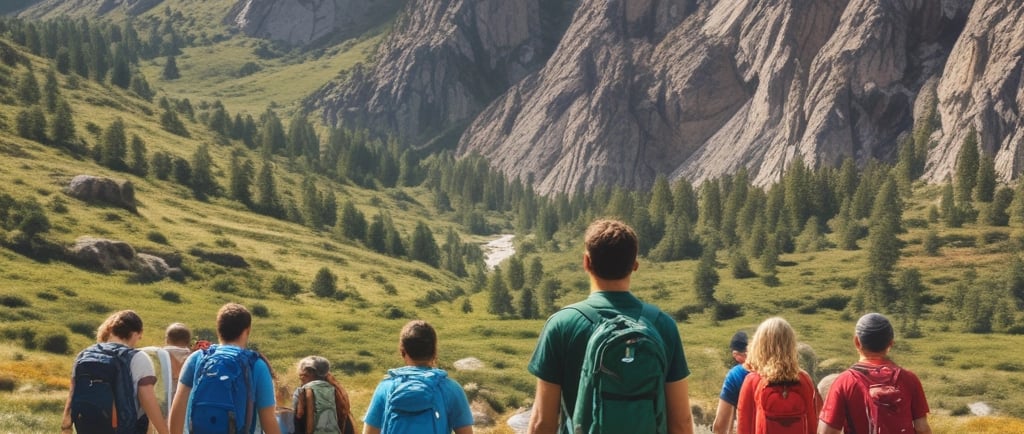4 Reasons to Explore Nature with Middle and High School Students
7/10/20234 min read


1. Enhancing Environmental Awareness
Exploring nature offers middle and high school students a unique opportunity to gain a deeper understanding of environmental issues. By immersing themselves in natural settings, students can develop a meaningful connection to their surroundings, which is crucial for fostering environmental awareness. This connection not only enhances their appreciation of ecosystems but also underscores the importance of biodiversity and the complexities associated with climate change.
One effective approach to engage students in environmental stewardship is through hands-on activities during outdoor excursions. For instance, organizing a local habitat restoration project can allow students to actively participate in preserving their environment. This experiential learning fosters a sense of responsibility and can spark conversations about the fragile nature of ecosystems and the role humans play in their preservation.
Additionally, educators can encourage students to conduct field studies, where they observe native flora and fauna, recording species and noting their habitat conditions. This not only helps students grasp the concept of biodiversity but also illustrates how various elements of an ecosystem are interconnected. Activities like nature journaling can promote reflection, enabling students to document their observations and express their thoughts on environmental health.
Furthermore, discussing real-world environmental challenges, such as climate change, during these explorations can create context and urgency around these issues. Encouraging students to engage in dialogue about solutions fosters critical thinking, preparing them to become informed citizens who advocate for sustainable practices.
By integrating these practical experiences into outdoor education, educators can effectively enhance students' environmental awareness. Such engagements not only cultivate respect for nature but also empower students to think critically about their impact on the environment and inspire them to be proactive in safeguarding our planet.
2. Fostering Teamwork and Collaboration
Exploring nature presents a unique opportunity for middle and high school students to enhance their teamwork and collaboration skills. Engaging in various outdoor activities, students are encouraged to work together in ways that promote trust, communication, and a sense of shared responsibility. These experiences are not only valuable for personal growth but also essential for developing social skills that are important in both academic and future professional settings.
Group activities such as team hikes, scavenger hunts, or survival challenges can serve as catalysts for collaboration. For instance, during a scavenger hunt, students can be divided into small groups and tasked with finding specific items in nature. This requires them to plan effectively, delegate tasks, and work towards a common goal. In addition, outdoor challenges such as rock climbing or obstacle courses necessitate reliance on each other’s strengths, fostering a spirit of teamwork.
Another effective method to promote teamwork in nature is through team-building exercises, such as trust falls or problem-solving games that are designed to strengthen relationships among peers. These activities encourage students to communicate openly, express their thoughts, and listen to others, which is crucial for effective collaboration. Furthermore, they allow students to understand diverse perspectives, thereby enriching their social experiences.
To facilitate a successful collaboration-focused experience, it is important to carefully design activities that are inclusive and adaptable to varying skill levels. Providing clear instructions and establishing ground rules can set the stage for a constructive environment. Additionally, allowing time for reflection post-activity can help students assess their performance, acknowledge their contributions, and encourage open dialogue about their collective experiences.
Through these collaborative outdoor experiences, middle and high school students can significantly enhance their ability to work as a team, an invaluable skill that will serve them in numerous situations throughout their lives.
3. Boosting Mental and Physical Health
Spending time in nature has been shown to yield significant health benefits, particularly for adolescents in middle and high school. The pressures of academic performance, social dynamics, and personal identity can contribute to high levels of stress and anxiety in teenagers. However, engaging with natural environments can serve as an effective remedy for these issues. Studies have demonstrated that outdoor activities can help lower cortisol levels, which in turn alleviates stress and promotes a more positive mood among students. Such interactions with nature are vital for fostering mental health and well-being during these formative years.
Moreover, physical health benefits are equally important. Activities such as hiking, cycling, or even simple walks in green spaces encourage bodily movement, which is crucial for maintaining a healthy lifestyle. Regular physical activity has been linked to improved cardiovascular health, enhanced muscle strength, and a lower risk of obesity. For adolescents who frequently spend ample time indoors, participating in outdoor adventures can significantly improve their physical fitness and overall health. Additionally, these activities can improve sleep patterns, further benefiting both mental and physical health.
To facilitate these advantages, educators should consider incorporating regular nature outings into their curricula. Specific activities that can be beneficial include nature hikes, organized sports in park settings, or outdoor science experiments. Such experiences not only allow students to explore and appreciate their natural surroundings but also provide them with the opportunity to engage in physical activity and enhance their mental resilience. Through the combination of physical exertion and the calming effects of nature, students are likely to experience a notable improvement in both their mental state and physical condition.
4. Encouraging Curiosity and Lifelong Learning
Exploring nature offers middle and high school students a unique opportunity to ignite their curiosity and inspire a profound love for learning. Direct interaction with the natural environment fosters essential observational skills and critical thinking. Engaging with nature allows students to experience concepts studied in the classroom in a tangible way, promoting a deeper understanding of various scientific principles.
By immersing students in outdoor settings, educators can encourage inquiry-based learning. For instance, teachers can pose open-ended questions such as, "What adaptations do you observe in this ecosystem?" or "How does this natural phenomenon occur?" This approach compels students to think critically about their surroundings and seek answers through investigation. Cultivating these skills not only boosts academic performance but also fosters a lifelong appreciation for the natural world.
In addition to inquiry-based techniques, hands-on learning experiences can be integrated into nature excursions to enhance student engagement. Activities such as plant identification, wildlife observation, and water quality testing allow students to collect data and analyze findings, bridging the gap between theory and practice. This experiential learning feeds into scientific inquiry by presenting students with real-world challenges and opportunities for problem-solving.
Furthermore, nurturing a sense of stewardship towards the environment through these explorations will instill values of conservation and sustainability in students. They will develop a deeper understanding of ecological interdependence and the importance of biodiversity. By encouraging students to engage with their surroundings actively, educators can help them become more conscious of their role in preserving nature. Thus, nature exploration becomes a powerful avenue for promoting curiosity, critical thinking, and a lifelong passion for learning. In conclusion, when students explore the great outdoors, they not only gain knowledge about science but also cultivate a deeper connection with the world around them.
